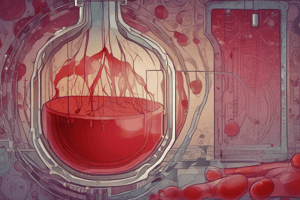Podcast
Questions and Answers
What is the primary function of a Third Rail Cover-Board?
What is the primary function of a Third Rail Cover-Board?
- To act as a support structure for the Track Indicator
- To attach to a series of brackets and provide cover over the Third Rail (correct)
- To protect the electrified Third Rail from environmental elements
- To provide a pathway for the contact shoe to ride onto the Third Rail
What is the purpose of a Transponder in a railroad system?
What is the purpose of a Transponder in a railroad system?
- To provide power to the Third Rail
- To detect the presence of a train at a switch location
- To control the speed of a train in Wayside Mode
- To allow the train to interrogate its current location (correct)
What is the function of a Watchman in a worksite?
What is the function of a Watchman in a worksite?
- To maintain the Third Rail Cover-Board
- To route trains through a Turnout
- To operate the interlocking signal system
- To communicate with the Engineer of an approaching train (correct)
What is the definition of a Train?
What is the definition of a Train?
What happens when a Train Stop is engaged?
What happens when a Train Stop is engaged?
What is the purpose of a Turnout?
What is the purpose of a Turnout?
What is a Work Train used for?
What is a Work Train used for?
What is the definition of Yard Mode?
What is the definition of Yard Mode?
What is the purpose of a Track Indicator?
What is the purpose of a Track Indicator?
What is a Third Rail Side Incline?
What is a Third Rail Side Incline?
Flashcards
Employee Identification
Employee Identification
Must be shown to supervision, police, security, or authorized personnel when asked.
Buzzer Signals
Buzzer Signals
A set of communications between the Conductor and Engineer.
One Short Buzzer Sound (_)
One Short Buzzer Sound (_)
Stop immediately.
Three Short Interlocking Whistle Sounds (___)
Three Short Interlocking Whistle Sounds (___)
Signup and view all the flashcards
Interlocking Signals
Interlocking Signals
Signup and view all the flashcards
Fouling
Fouling
Signup and view all the flashcards
Benchwall
Benchwall
Signup and view all the flashcards
Frog (Track)
Frog (Track)
Signup and view all the flashcards
Gap Train
Gap Train
Signup and view all the flashcards
Indication (Signal)
Indication (Signal)
Signup and view all the flashcards
Study Notes
General Rules of Conduct
- Employees must display and produce required identification credentials to supervision, Port Authority Police, security personnel, or authorized representatives upon request.
- Employees on duty must have a copy of the following in their possession or at an accessible location:
- Book of Rules
- Required books and manuals for their craft
- Notices and forms required to perform duties correctly
- Identification or certification required for duties
Rules and Special Instructions
- Employees must know and obey all general rules, special instructions, and applicable General Notices.
- Ignorance of rules and regulations will not be accepted as an excuse for neglect or omission of duty.
Attention to Duties
- Employees must devote themselves exclusively to PATH service while on duty and report any violations of rules and special instructions to the proper official.
- Participation in unauthorized activities while on duty or on PATH property is prohibited.
- Employees must perform all tasks assigned or directed to them by proper authority.
Prohibited Conduct
- Employees must be of good character and not commit dishonest, immoral, illegal, violent, insubordinate, disruptive, destructive, or reckless acts.
- Employees must conduct themselves at all times, whether on or off PATH property, in a manner that does not bring discredit upon PATH.
Treatment of Customers
- The traveling public must be treated with courtesy and consideration.
- Employees must not engage in disputes or quarrels with customers and may not have unnecessary physical contact with customers.
Drugs and Alcohol
- Possession or use of intoxicants or narcotics by employees while on duty is prohibited.
- Employees may not present themselves for or perform any service for PATH while under the influence of intoxicants or narcotics.
Buzzer Signals
- Buzzer signals are used for onboard communication between the Conductor and Engineer.
- Sound indications:
- _: STOP at once
- __: START
- ooo: BACK UP, used when standing
- ___: Stop at next station or employee stop, used when running
- ____: Apply or Release Brakes, used during air brake test
- o_o: Request for the Conductor to contact the Engineer
Interlocking Whistle Signals
- Sound indications:
- _: All movements within interlocking limits STOP immediately
- oo: Resume normal movement after receiving the proper signal or permission of Tower Operator
- ___: Call for Car Inspector
- ____: Call for Signal Maintainer
- ooooo: Call for Trackman or Power Rail Maintainer
Fixed Signals
- Fixed signals are divided into three classes:
- A. Interlocking Signals: govern trains entering and using a route, identified by a plate with the signal's number and letters, including the letter "X".
- B. Automatic Block Signals: govern the movement of approaching trains, identified by number and the letter Z or D.
Definitions
- Fouling: when a person or equipment could be struck by a moving train or is within four feet of the field side of the near running rail.
- Benchwall: a designated safety zone that must remain unobstructed.
- Frog: a track device that permits wheels to cross an intersecting rail.
- Gap Train: a train operated to replace or augment a regular schedule.
- Indication (Signal): the information conveyed by a signal aspect.
- Interlocking: an arrangement of signals and signal appliances that route trains from one track to another.
- Interlocking limits: the tracks between the opposing home signals of an interlocking.
- Interlocking Signal: a fixed signal at the entrance of a route, identified by a plate with the signal's number and letters, including the letter "X".
- Lamp: a flashlight or other lighted instrument.
- Light Train: a train operated without customers.
- Locomotive (MU): rail rolling equipment self-propelled by any power source.
- Third Rail Cover-Board: a non-conductive material board that provides cover over the Third Rail.
- Third Rail Side Incline: an electrified extension along the side of the Third Rail that allows the contact shoe to ride up onto the Third Rail at switch locations.
- Track Indicator: an illuminated device used in conjunction with an interlocking signal to indicate the track to which the train will be routed.
- Transponder: a passive device mounted in the road bed that the train will interrogate to identify its current location.
- Trailing Point Switch: a switch where the train or railroad equipment approaches from one of the two diverging routes.
- Train: one or more rail cars, coupled together, displaying proper front and rear lights, with a crew and destination.
- Train Stop: a roadway element that when engaged will automatically result in an emergency brake application.
- Turnout: an arrangement of a switch and a frog that permits a train or other rail vehicle to be transferred from one track to another.
- Watchman: a person designated at a worksite to warn the work group of an approaching train and who can communicate with the Engineer of an approaching train.
- Wayside Mode: a territory where CBTC has no control over CBTC-equipped trains, and the train automatically transitions to Wayside Mode.
- Work Train: one or more non-passenger cars for the purpose of supporting construction or maintenance work activity on PATH.
- Yard: a system of tracks provided for the making up of trains, storing of rail cars, and other purposes.
- Yard Mode: ATC Carborne equipment limits the speed of train movement in CBTC yard to 12MPH, but does not otherwise constrain the train movement.
Studying That Suits You
Use AI to generate personalized quizzes and flashcards to suit your learning preferences.



